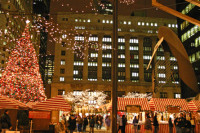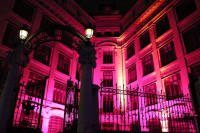Anniversaries
Parisian landmarks are celebrating in 2010! – All built for the World Fair of 1900
1900 was an important year for the town of Paris: it was the year of the World Fair, known as the Exposition Universelle. Having won over Berlin in 1892 the chance to bring the world to them, the organizers had to get ready. For this occasion many buildings, a train station, bridges and even the subway were constructed.
It was not the first time that Paris was organizing a World Fair but it was an important one, as being the last one of the century. Everything had to look elegant for the visitors, something to remember architecturally.
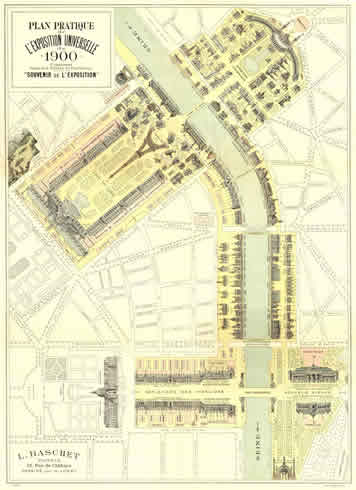
Souvenirs de l’exposition 1900 – Plan Pratique – Editeur Baschet Paris 1900
In 1896 the president of the World Fair, Alfred Picard launched competitions and received hundred of propositions for all of the projects.
The year of the World Fair in Paris, the Grand Palais, Petit Palais, the Alexander III bridge, the French subway Line 1 and the Orsay train station had been built. Inauguration was from April through July 1900.
Emil Loubet, President of France at that time, opened the World Fair on April 15th, ending on November 12th, 1900.
Let’s look at the history of these famous Parisian landmarks:
The Petit Palais:
You may have gone to the Petit Palais when visiting Paris. It is a museum since December 1902 with 45,000 art of works, from which are 1300 paintings. The collection holds Greek and Roman art but also works from the Renaissance through today. The fortunate French brothers, Eugène and Auguste Dutuit (1900’s), as well as the American banker, Edward Tuck, donated some of their art collection to the museum (1930’s).
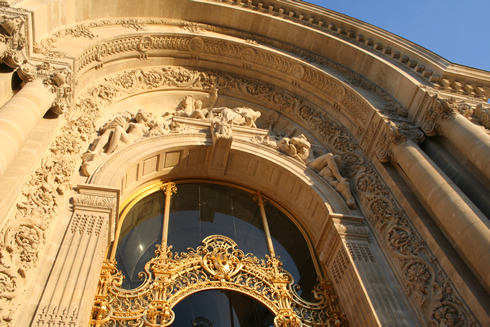
Facade of the Petit Palais at sunset
The Petit Palais is located near the Champs Elysées on the Avenue Winston Churchill in the 8th arrondissement.
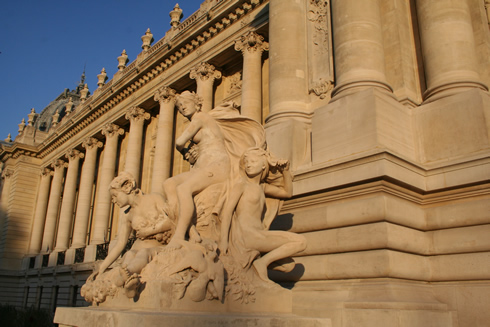
Outside of the Petit Palais
The building, in a trapezium shape and made of steel with a stone facade, is the work of the architect Charles Girault. After having won the competition among 33 propositions, Girault worked on the building for 3 years.
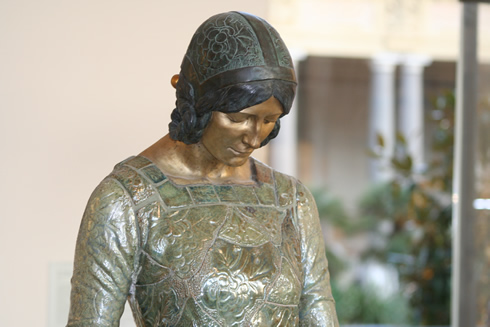
Statue: Lady with a monkey from Camille Alaphillippe (1908)
If you don’t have much time for the museum, it is worth to stop at least to look at the interior semi-circular garden with its columns, amazing vaulted ceiling, mosaics and painted murals.
The Grand Palais:
The Grand Palais was built on the place of the last Palace of Independence, which had been constructed in 1855 and demolished for the World Fair. It is located on the other side of the Petit Palais.
Four architects won the competition out of 49 propositions, to build the Grand Palais. The major architect was Henri Deglane.
It took three years from 1897 and up to 1500 workers to finish the building, an historical monument since november 1975. Deglane worked on the facade and the nave. The entire project was coordinated by the architect Charles Girault, who had worked on the Petit Palais.
!["Paris Exposition: Grand Palais, Paris, France, 1900" copyright Brooklyn Museum and Goodyear Brooklyn Museum: Visual materials [6.1.014]: Paris Exposition photographs.](http://vivamost.com/cms/media/s/S03i1516n01a.jpg)
“Paris Exposition: Grand Palais, Paris, France, 1900” copyright Brooklyn Museum and Goodyear
Deglane and Girault knew each other well as they were friends.
The result of the Grand Palais was absolutely magnificent, a mixture of iron, glass and steel in classical-art nouveau style. It has slightly more steel than the Eiffel Tower, 8,500 tons compared to 8,000 tons.
Two weeks after the opening of the World Fair in April 1900, opened the Grand Palais. By the time the fair had closed, 50 millions of people had come to the exhibition hall.
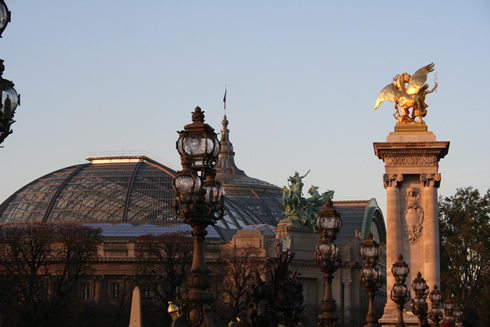
outside of the Grand Palais, Paris
It was finished on time but it had taken much longer than expected due to problems while building the biggest glass roof in Europe. Work had to be interrupted for 8 months until money was found to add more oak pillars to the foundation in the nave. This had not been originally planned.
The nave is 200 meters in length. In 1993 it was closed to the public when a problem was found in the construction. It underwent massive renovations from 2001-2005 and reopened to the public in 2005.
From 2001-2007, the renovations at the Grand Palais including nave, facade, mosaics, statues, glass framework, amounted to more than 101 Millions euros. Today the president of the Grand Palais, Jean-Paul Cluzel, wants to renovate the interior to gain 30% more space. It should cost 236 Millions euros!
The Grand Palais today is much more than art exhibits. Here is what you could or can see:
- music shows like Electro night and concerts like Prince (the 11,000 concert tickets were sold in 77 seconds)
- fashion shows like the ones from Yves St. Laurent and Chanel
- sport shows like fencing rollers and skateboards
Since it opened it saw horse and air shows and the treasures of Egypt.
Don’t miss the big staircase, mosaic and imposing glass roof. For art exhibits ending next January, you can see:
- Claude Monet: Sept-Jan 24th, 2011
- Bulgari 125 years of Italian Magnificence: Dec 10th-Jan 12th, 2011
- Between Middle Ages & Renaissance: October to Jan 10th, 2011
- Fencing: October to Jan 9th, 2011
Have you visited the Grand Palais this year? In 2009, 785,136 people went there.
The Parisian Subway-Metropolitain:
Like the other large world capitals Paris needed a subway and had been thinking about it for a long time. With the World Fair coming up, it was a good opportunity to get started. This would help facilitating the movement of people in the city.
The work started with the engineer Florence Bienvenue, in October 1898 and was finished after 20 months on July 19th, 1900. The architect chosen to make the Art Nouveau entrances was Hector Guimard. He remained famous for the sign Metropolitain, green steel works and red lamps and glass canopy.
For the inauguration of the first subway line called Line 1, only 8 stations were finished. By September 1st, 10 more stations were opened, making it to a total of 18 stops from Porte Vincennes to Porte Maillot.
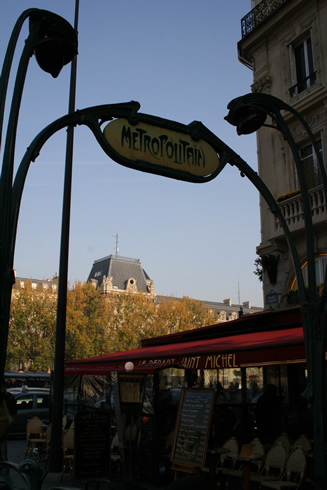
A station of the Metro in Paris
The Gare d’Orsay:
Today’s well-known museum of art, the Musée d’Orsay, was once a train station! It was built by the French company Orléans Railroad Company, which wanted to bring people from the Southwest of France to Paris.
The architect Victor Laloux won the competition. He had the task to make a station that would fit well with the beautiful surroundings and had to look like a work of art. Stone, stucco and metal were used. It was inaugurated on the French national day on July 14th,
1900.
Known as the first French train station with electric trains, it was used as a train station from 1900 to 1939. Later it became a mail service center and it was used for movies, theaters and auctions.
In 1977 the French President, Giscard d’Estaing, decided it would become a museum. On December 9th, 1986, President Mitterand inaugurated the Musée d’Orsay, whose works are from the middle of the 19th century to the beginning of the 20th century.
Since its opening, 63,744,677 visitors have come to the museum.
The Alexander III Bridge:
The architect of the Alexander III Bridge didn’t have an easy task, building an arch bridge without blocking the outstanding view around it. One still had to be able to see the Champ-Elysées nearby.
The bridge carrys the name of the Russian Tsar, Alexander III, whose son, Nicholas, is said to have laid the first stone in 1896.
It took three years to finish the most beautiful bridge in Paris as it is often said. Two architects, two engineers and many artists worked on this Art Nouveau bridge made of stone and steel. It has four gilted pillars, two at each end, of 17 meters in height. Beautiful sculptures of nymphs and angels decorate the bridge.
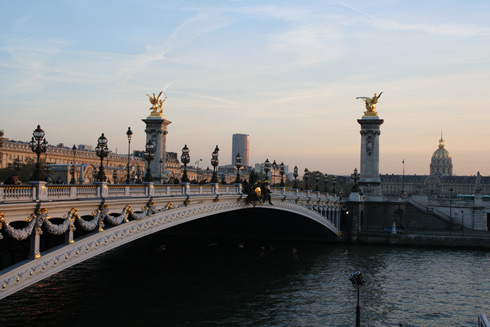
View of the Bridge Alexander III at sunset with Invalides
When coming from the Invalides, you just need to cross the river Seine to go to the Grand Palais and Petit Palais. Not far is the Eiffel Tower, so it is an amazing place to watch the sunset.
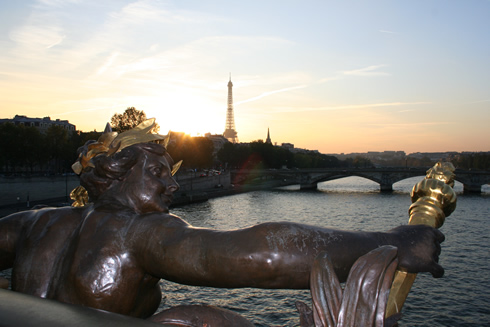
Parisian sunset from Alexander III bridge with Eiffel Tower

